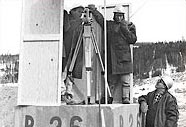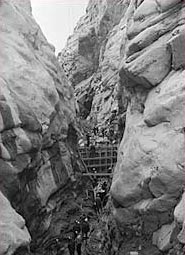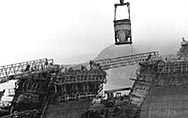Technical Prowess and 735-kV Lines
Manic–Outardes
The development of the Manicouagan and Outardes rivers was not without obstacles. In fact, the engineers had to solve unexpected problems at every generating station site. As technical feats followed one after another at the work sites, Manic-Outardes became a kind of symbol of the Quiet Revolution.
- Manic-5 is the world’s largest multiple-arch dam. Before it was built, alluvial deposits had to be removed from the riverbed to a depth of more than 50 metres. The workers called this spot Manic-5’s "hollow tooth". During Montréal’s Expo 67, visitors to the Hydro-Québec Pavilion could view the concreting work on a giant screen. On September 25, 1968, the day the dam was inaugurated, Québec Premier Daniel Johnson died. A year later, Manic-5 dam was renamed after him.
- Manic-2 boasts the largest hollow gravity dam in the world. All the components of this project—dam, water intake, penstocks, spillway, powerhouse and step-up substation—stand together as a single well-proportioned structure.
- At the Manic-3 site, another "hollow tooth" was discovered, reaching a depth of over 120 metres in the riverbed. A double cut-off wall had to be built so that water would not seep under the dam.
- The Outardes-3 and Outardes-4 sites also held some surprises for the builders: porous cavities, the so-called "giant's pots", were discovered at an unexpected depth and needed to be drained and sealed with concrete to ensure the dams were watertight.
- By the time the Manic-Outardes complex was completed 20 years later, it consisted of seven generating stations: Manic-1, Manic-2, Manic-3, Manic-5 (Daniel-Johnson dam), Outardes-2, Outardes-3 and Outardes-4.
- To meet peak demand on Hydro-Québec's system, another generating station, Manic-5 PA, was commissioned in 1989 to add capacity. In order to prevent cracking of the concrete and to protect the Daniel-Johnson dam against the effects of the large variations in temperature, which are frequent at the latitude of Manicouagan, a thermal improvement was installed, in 1991, in 9 of the dam's 13 arches. The base-covers fit the shape of the arches perfectly, thus preserving the aesthetics of the dam.



